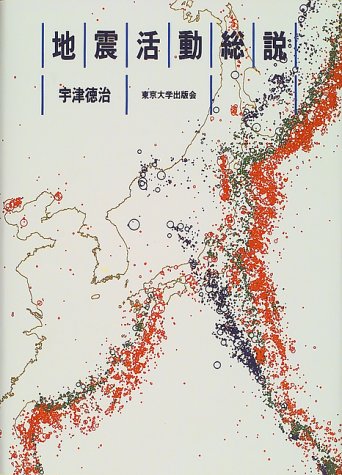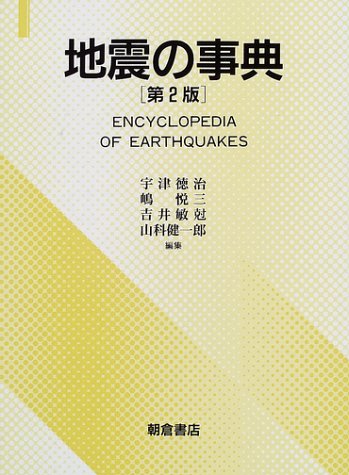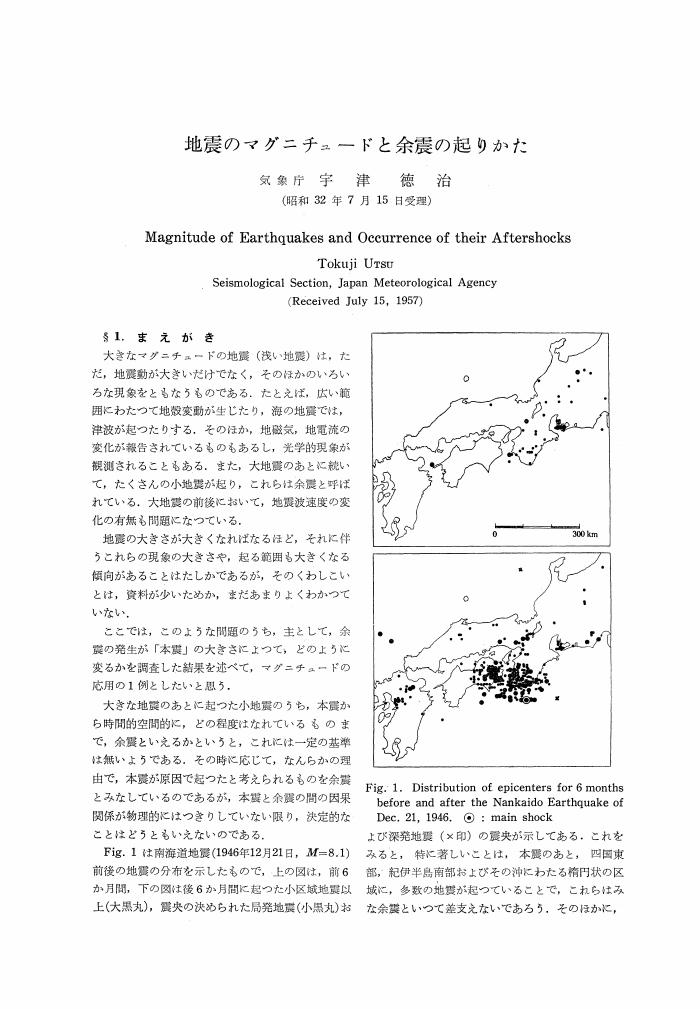1 0 0 0 地震の事典
- 著者
- 宇津徳治 [ほか] 編
- 出版者
- 朝倉書店
- 巻号頁・発行日
- 2001
1 0 0 0 IR 日本付近のM6.0以上の地震および被害地震の表:1885年〜1980年
- 著者
- 宇津 徳治
- 出版者
- 東京大学地震研究所
- 雑誌
- 東京大学地震研究所彙報 (ISSN:00408972)
- 巻号頁・発行日
- vol.57, no.3, pp.p401-463, 1982
- 被引用文献数
- 22
A catalog of earthquakes of magnitude 6 or more felt in Japan and smaller earthquakes which caused damage in Japan from 1885 through 1980 is presented. The catalog also contains unfelt earthquakes of M≧6 which occurred in the vicinity of Japan (region A indicated in the map), but the listing of unfelt earthquakes may be incomplete for the years before 1924. The catalog is incomplete for deep earthquakes before 1900. The main sources of materials are Utsu's catalog of 1979 (revised in 1982) for 1885-1925, the new JMA catalog (1982) for 1926-1960, and the JMA Seismological Bulletin for 1961-1980. Gutenberg-Richter's catalog (1954), ISS, or ISC Bulletins are used for focal coordinates of earthquakes occurring outside of the network of JMA stations. For some earthquakes the author has determined the focal coordinates or magnitudes. Statistical analyses of the catalog and studies of seismicity patterns in relation to the occurrence of great earthquakes will be published elsewhere.
- 著者
- 宇津 徳治
- 出版者
- 東京大学地震研究所
- 雑誌
- 東京大学地震研究所彙報 (ISSN:00408972)
- 巻号頁・発行日
- vol.61, no.4, pp.p551-561, 1987-03
- 被引用文献数
- 2
日本のマントル最上部地震(深さ40~80km程度,ただし異常震域が現れる東日本の太平洋岸沖合の地震や北海道太平洋沿岸の地震を除く)に対する震度I(気象庁震度階級),震央距離Δ(km),マグニチュードM(気象庁方式)の標準的関係を表す実験式を132個の地震(M : 5~7)の震度データを用いて求めた.I-Δの平均回帰直線I=I100-b(Δ-100)の定数を,次の式でMと結んだものを提出する.I100=1.5M-6.1 b=0.0523-0.0063Mこれらの式によりあるM,Δに対する震度を求めたとき,得られた値の小数点以下を四捨五入したものが整数値で表される通常の震度になる.
1 0 0 0 OA 前震と群発地震の識別に関する一調査
- 著者
- 宇津 徳治
- 出版者
- 公益社団法人 日本地震学会
- 雑誌
- 地震 第2輯 (ISSN:00371114)
- 巻号頁・発行日
- vol.31, no.2, pp.129-135, 1978-07-31 (Released:2010-03-11)
- 参考文献数
- 7
- 被引用文献数
- 2 1
Discrimination of foreshock sequences from earthquake swarms is an important problem in earthquake prediction. In this paper, the magnitudes of the largest, the second largest, and the third largest shocks in an earthquake swarm or foreshock sequence are denoted by M1, M2, and M3, respectively, and Japanese shallow earthquake swarms and foreshock sequences (with M1-M2≤0.6 and M1≥5.0 for 1926-64 or M1≥4.5 for 1965-77) are classified according to the values of M1-M2 and M1-M3, and the time sequence of the shocks of M1 and M2. If we select the earthquake swarms and foreshock sequences satisfying the following conditions, the highest proportion of foreshock sequences to earthquake swarms is achieved. The conditions are: (1) 0.4≤M1-M2≤0.6, (2) M1-M3≥0.7 (or M3 is too small to be determined), and (3) the shock of M2 precedes the shock of M1. The numbers of foreshock sequences and earthquake swarms selected under these conditions are 10 and 17, respectively, while the total numbers of foreshock sequences and earthquake swarms are 13 and 232, respectively. It is confirmed that the above criterion is also effective, if it is used during the course of an earthquake sequence.
1 0 0 0 OA 6.地震の規模別度数の統計式log n=a-bMの係数bを求める一方法
- 著者
- 宇津 徳治
- 出版者
- 北海道大学理学部地球物理学教室
- 雑誌
- 北海道大学地球物理学研究報告 (ISSN:04393503)
- 巻号頁・発行日
- vol.13, pp.99-103, 1965-02-25
1 0 0 0 OA 震央付近の震度-震源の深さ-マグニチュードの関係
- 著者
- 宇津 徳治
- 出版者
- 東京大学地震研究所
- 雑誌
- 東京大學地震研究所彙報 = Bulletin of the Earthquake Research Institute, University of Tokyo (ISSN:00408972)
- 巻号頁・発行日
- vol.63, no.1, pp.23-31, 1988-06-30
日本の地震について,震央付近の震度I0(気象庁震度階級),マグニチュードM(気象庁方式),震源の深さh(km)の標準的関係を表す実験式を1114個の震度データを用いて求め,次式を得た.M=0.23 I0+0.105 I02+1.2log h+1.3この式はMが2~8,hがO~100km.I0がO~6の地震を対象としている.ただしh=Oと発表されている地震の実際の深さは数kmと考えて,h<3kmの場合はh=3kmと置く,Mが5程度より大きい地震についてはm=1.2I0+1.21log h-0.83すなわちI0=O.83 M-log h+0.71を用いてもよい.
1 0 0 0 OA 日本付近のM6.0以上の地震および被害地震の表 : 1885年~1980年
- 著者
- 宇津 徳治
- 出版者
- 東京大学地震研究所
- 雑誌
- 東京大學地震研究所彙報 = Bulletin of the Earthquake Research Institute, University of Tokyo (ISSN:00408972)
- 巻号頁・発行日
- vol.57, no.3, pp.401-463, 1983-01-17
A catalog of earthquakes of magnitude 6 or more felt in Japan and smaller earthquakes which caused damage in Japan from 1885 through 1980 is presented. The catalog also contains unfelt earthquakes of M≧6 which occurred in the vicinity of Japan (region A indicated in the map), but the listing of unfelt earthquakes may be incomplete for the years before 1924. The catalog is incomplete for deep earthquakes before 1900. The main sources of materials are Utsu's catalog of 1979 (revised in 1982) for 1885-1925, the new JMA catalog (1982) for 1926-1960, and the JMA Seismological Bulletin for 1961-1980. Gutenberg-Richter's catalog (1954), ISS, or ISC Bulletins are used for focal coordinates of earthquakes occurring outside of the network of JMA stations. For some earthquakes the author has determined the focal coordinates or magnitudes. Statistical analyses of the catalog and studies of seismicity patterns in relation to the occurrence of great earthquakes will be published elsewhere.
1 0 0 0 OA 震度-震央距離-マグニチュードの関係 : その1.東日本太平洋岸沖合を除く日本の浅発地震
- 著者
- 宇津 徳治
- 出版者
- 東京大学地震研究所
- 雑誌
- 東京大學地震研究所彙報 = Bulletin of the Earthquake Research Institute, University of Tokyo (ISSN:00408972)
- 巻号頁・発行日
- vol.59, no.2, pp.219-233, 1984-10-20
日本の浅発地震(ただし東日本の太平洋岸沖合を除く)に対する震度I(気象庁震度階級),震央距離Δ(km),マグニチュードM(気象庁方式)の標準的関係を表わす実験式を181個の地震(M:5~8)の震度データを用いて求めた.このような標準式を定めるうえで生ずるいくつかの問題について議論したが,若干の問題は解決が困難で適当に処理せざるを得ない.本論文ではI-Δの平均回帰直線I=I100-b(Δ-100)の定数を,次の式でMと結んだものを標準式として提出する.I100=1.5M-6.5 b=0.0767-0.015M+0.0008M2なお,使用目的によっては本文中に掲げられている別の式を用いるほうが適当な場合もあろう.
1 0 0 0 OA 1885年~1925年の日本の地震活動 : 訂正と補遺
- 著者
- 宇津 徳治
- 出版者
- 東京大学地震研究所
- 雑誌
- 東京大學地震研究所彙報 = Bulletin of the Earthquake Research Institute, University of Tokyo (ISSN:00408972)
- 巻号頁・発行日
- vol.57, no.1, pp.111-117, 1982-07-16
On the basis of newly collected data, a revision of the catalog of earthquakes in Japan between 1885 and 1925 (UTSU, 1979) has been made.
1 0 0 0 世界の被害地震の表 : 古代から1989年まで
1 0 0 0 OA 地震のマグニチュードと余震の起りかた
- 著者
- 宇津 徳治
- 出版者
- 公益社団法人 日本地震学会
- 雑誌
- 地震 第2輯 (ISSN:00371114)
- 巻号頁・発行日
- vol.10, no.1, pp.35-45, 1957-08-25 (Released:2010-03-11)
- 被引用文献数
- 45
1 0 0 0 OA 日本付近のM6.0以上の地震および被害地震の表 : 1885年~1980年
- 著者
- 宇津 徳治
- 出版者
- 東京大学地震研究所
- 雑誌
- 東京大学地震研究所彙報 (ISSN:00408972)
- 巻号頁・発行日
- vol.57, no.3, pp.401-463, 1983-01-17
A catalog of earthquakes of magnitude 6 or more felt in Japan and smaller earthquakes which caused damage in Japan from 1885 through 1980 is presented. The catalog also contains unfelt earthquakes of M≧6 which occurred in the vicinity of Japan (region A indicated in the map), but the listing of unfelt earthquakes may be incomplete for the years before 1924. The catalog is incomplete for deep earthquakes before 1900. The main sources of materials are Utsu's catalog of 1979 (revised in 1982) for 1885-1925, the new JMA catalog (1982) for 1926-1960, and the JMA Seismological Bulletin for 1961-1980. Gutenberg-Richter's catalog (1954), ISS, or ISC Bulletins are used for focal coordinates of earthquakes occurring outside of the network of JMA stations. For some earthquakes the author has determined the focal coordinates or magnitudes. Statistical analyses of the catalog and studies of seismicity patterns in relation to the occurrence of great earthquakes will be published elsewhere.
1 0 0 0 OA 日本列島下の上部マントルにおけるVp/Vsについて
- 著者
- 宇津 徳治
- 出版者
- 公益社団法人 日本地震学会
- 雑誌
- 地震 第2輯 (ISSN:00371114)
- 巻号頁・発行日
- vol.22, no.1, pp.41-53, 1969-05-30 (Released:2010-03-11)
- 参考文献数
- 16
- 被引用文献数
- 4
Arrival times of P and S waves at Japanese stations from 33 intermediate and deep earthquakes in and near Japan are plotted in the form of S-P vs. P plots. Most of the plotted points for each earthquake (except one which occurred in Kyushu) fit a straight line with a slope of about 0.77. This means that the velocity ratio of P to S waves is about 1.77 and Poisson's ratio is about 0.265 for the portion of the upper mantle concerned. It should be emphasized that the ratio does not differ significantly between the two distinctive portions of the upper mantle, i. e., the inclined deep seismic layer of high-Q and high-V and the overlying wedge-shaped region of low-Q and low-V. For certain deep earthquakes, plotted points in ranges of larger S-P deviate systematically from the straight lines fitted to points in ranges of smaller S-P. From this deviation it is suggested that a portion of the upper mantle under the deep seismic layer has a comparatively large Poisson's ratio.
1 0 0 0 OA 震度-震央距離-マグニチュードの関係 : その1.東日本太平洋岸沖合を除く日本の浅発地震
- 著者
- 宇津 徳治
- 出版者
- 東京大学地震研究所
- 雑誌
- 東京大学地震研究所彙報 (ISSN:00408972)
- 巻号頁・発行日
- vol.59, no.2, pp.219-233, 1984-10-20
日本の浅発地震(ただし東日本の太平洋岸沖合を除く)に対する震度I(気象庁震度階級),震央距離Δ(km),マグニチュードM(気象庁方式)の標準的関係を表わす実験式を181個の地震(M:5~8)の震度データを用いて求めた.このような標準式を定めるうえで生ずるいくつかの問題について議論したが,若干の問題は解決が困難で適当に処理せざるを得ない.本論文ではI-Δの平均回帰直線I=I100-b(Δ-100)の定数を,次の式でMと結んだものを標準式として提出する.I100=1.5M-6.5 b=0.0767-0.015M+0.0008M2なお,使用目的によっては本文中に掲げられている別の式を用いるほうが適当な場合もあろう.
1 0 0 0 異常震域現象とマントル上部の地震波吸収の地域性
- 著者
- 宇津 徳治
- 出版者
- 日本地震学会
- 雑誌
- 地震 (ISSN:00371114)
- 巻号頁・発行日
- vol.19, no.3, pp.226-227, 1966-12
1 0 0 0 OA 震央付近の震度-震源の深さ-マグニチュードの関係
- 著者
- 宇津 徳治
- 出版者
- 東京大学地震研究所
- 雑誌
- 東京大学地震研究所彙報 (ISSN:00408972)
- 巻号頁・発行日
- vol.63, no.1, pp.23-31, 1988-06-30
日本の地震について,震央付近の震度I0(気象庁震度階級),マグニチュードM(気象庁方式),震源の深さh(km)の標準的関係を表す実験式を1114個の震度データを用いて求め,次式を得た.M=0.23 I0+0.105 I02+1.2log h+1.3この式はMが2~8,hがO~100km.I0がO~6の地震を対象としている.ただしh=Oと発表されている地震の実際の深さは数kmと考えて,h<3kmの場合はh=3kmと置く,Mが5程度より大きい地震についてはm=1.2I0+1.21log h-0.83すなわちI0=O.83 M-log h+0.71を用いてもよい.
1 0 0 0 OA 1885年~1925年の日本の地震活動 : 訂正と補遺
- 著者
- 宇津 徳治
- 出版者
- 東京大学地震研究所
- 雑誌
- 東京大学地震研究所彙報 (ISSN:00408972)
- 巻号頁・発行日
- vol.57, no.1, pp.111-117, 1982-07-16
On the basis of newly collected data, a revision of the catalog of earthquakes in Japan between 1885 and 1925 (UTSU, 1979) has been made.
1 0 0 0 OA 二つの地震群に対するb値の違いの有意性の検定
- 著者
- 宇津 徳治
- 出版者
- 公益社団法人 日本地震学会
- 雑誌
- 地震 第2輯 (ISSN:00371114)
- 巻号頁・発行日
- vol.20, no.1, pp.54-56, 1967-06-25 (Released:2010-03-11)
- 参考文献数
- 3
- 被引用文献数
- 2



